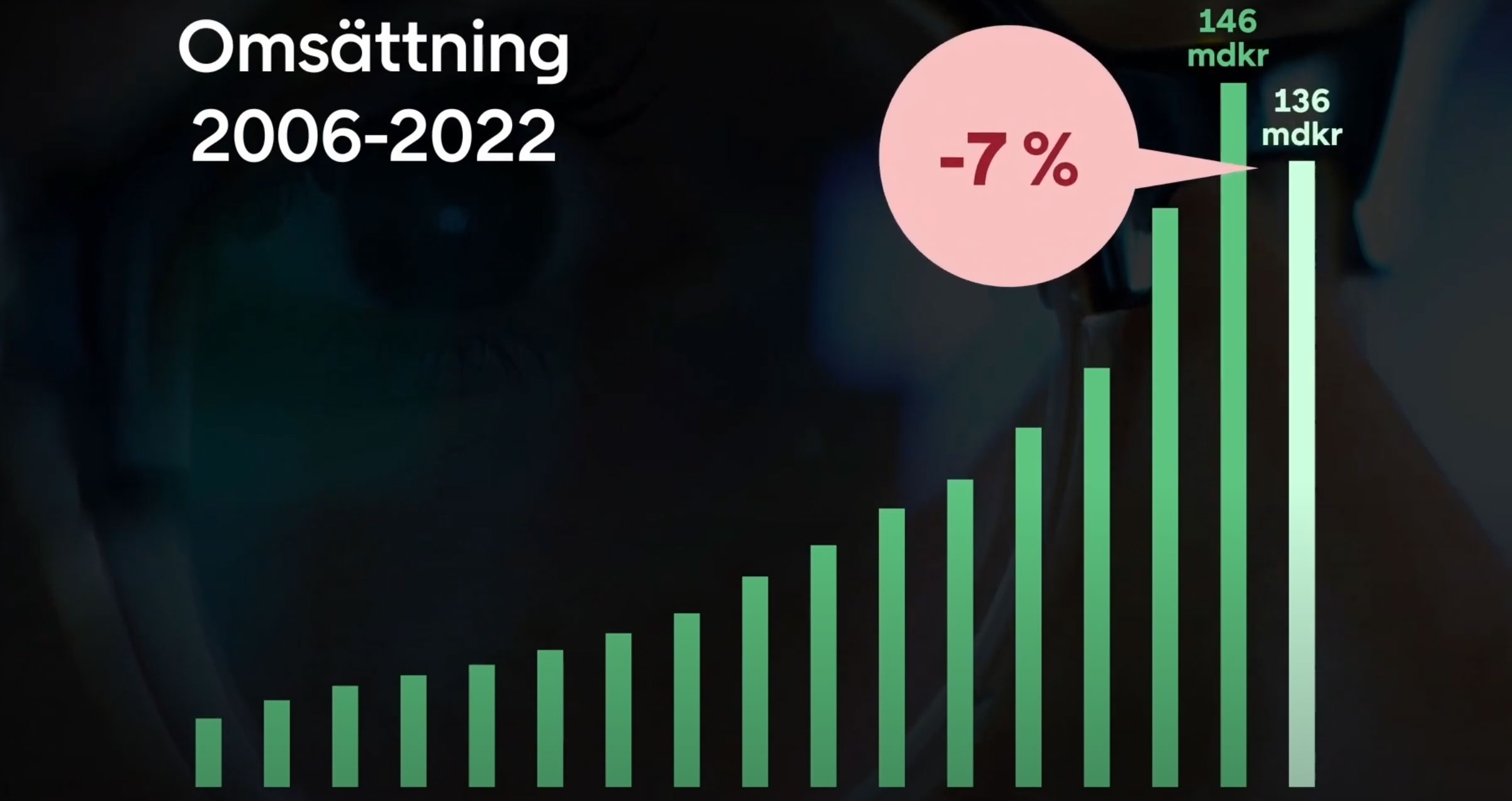The report E-barometern 2022
E-commerce's turnover fell by 7% for the whole year in Sweden, the report E-barometern showed in 2022, with a total turnover of 136 billion SEK compared to 147 billion in 2021. The pharmacy trade increased by 10% and has managed to maintain its sales even after the pandemic with positive figures quarter after quarter. Every fifth purchase of pharmacy products is now made online. Fashion retail is another category that also grew in 2022. However, online grocery sales fell 17% as more consumers returned to shopping in brick-and-mortar grocery stores after the pandemic and are looking for bargains as inflation rises.

An important part of the buying experience is being able to choose the delivery method that suits the customer. Expanded infrastructure and more choices in the checkout mean that 71% of consumers indicate that they were able to choose the delivery option they wanted during their last e-commerce purchase. A steady increase from 43 percent in 2017.
What does tomorrow's consumption landscape look like?
Moon-Suck Song, CEO and co-founder, Panagora, talked about the drivers of changing consumer behavior.
The first wave is about the rebels. The actors who took something that usually costs money and made it free. Those who can then capitalize on this change come out as winners, the way we currently consume music and film are such examples.
How fast Internet we have and all the hardware development is what he calls the second wave that deals with technology. We have gone from having file downloads and streaming to whole cities connecting with fast 5G. The more digital devices we use, the faster digital transformation.
The third wave is about when the digital transformation takes place all over the world, successful companies with enormous values are born. When that valuation goes up faster than for traditional companies, they also get the money to be able to grow and become the master of the block.
The global pandemic is what is referred to as the fourth wave, when there are regulations. Already in 2003 during the SARS outbreak, many people in China were afraid to go out and that is what laid the foundation for how big Alibaba became. With the Corona pandemic, this happened instead on a global level and for the first time we have gone from rebellious consumer behavior, rebel commerce, to regulated consumer behavior where we were asked not to visit physical stores, or in some cases were forbidden.
The amount of changes we have seen in recent decades will take place at an even faster pace in the next few years when the infrastructure is in place.

The search for new revenue streams where you meet tomorrow's consumer
Lina Hasic, E-commerce director, Kronans Apotek, has started looking at Metaverse as the next step in the Internet. They have built a 700 square meter pharmaverse. They are testing training courses and virtual patient meetings. Right now they work with their own employees and suppliers. During March, their own employees will be able to carry out a Stop Smoking training in their Metaverse. They will continue to evaluate internally and focus on the parts that get a good response before opening to consumers.
How can we better understand the changing behavior of consumers?
Sara Rosengren, Professor of Retail at the School of Economics, talked about easier consumption as a way out of the recession. In the 2008 financial crisis, low prices were one of the winners, but she highlights the consumer's view of time and ownership as something she thinks we should keep an eye on. The fact that we want to be able to buy what we want when we want has been a major focus for a long time, but she sees that anticipation has started to shift, Christmas shopping starts earlier, lower prices can be offered if you wait longer for an item. A simpler consumption could perhaps be to share the value that exists if we can postpone the consumption a little while waiting, for example, for a delivery that takes longer and offer a more planned consumption.
Johan Munck, CEO at Polarn O. Pyret, later told us about their investment in second hand, where you can take advantage of the customers' high-quality products and sell them again – a sustainable initiative for the children's clothes that are quickly outgrown without having been worn according to their motto "3 children in each garment".
User behaviors and consumer patterns on TikTok
Sandra Lagergren, Brand Strategy Lead Nordics, TikTok, talked about their broadcasting platform and the users there. She describes TikTok as a creative community platform, you don't just reach an individual user but an entire community. The trade that is conducted there goes under the concept of Community Commerce. The creators have a big influence on whether the users buy a product or not, it could be that they review, visit a store, use or try a product. When they have researched what works best, it is stated that it is recognizable, authentic, believable and everyday, preferably with a humorous touch. They have also looked at what those who use TikTok expect, and it is mainly to discover, learn something new, stay updated, be entertained, uplifted and engaged and be involved.
Increased value through strategic pricing
Kristoffer Cedfors, Director of Commercial Strategy at Verdane, has extensive experience in pricing, both as a consultant and in industry. We need to create more value in order to charge a higher price. He believes that the future is about creating experiences with the products, for example Christmas calendars – think about what could be your kind of Christmas calendar where you collect products as an experience package. Package solutions are another example so that you can offer a complete package of products so that you are sure that the customer gets everything they need. You can also look at the possibility of creating your own brand, either primarily or as part of the long-term investment. Something that, for example, Lager 157 did 8 years ago when they switched to only working with EMV, own brand products, a success for their business that Stefan Palm, CEO and founder talked about later.
To achieve profitability in a turbulent time, Kristoffer gives three tips:
- Remember to focus on the price – that's the most important thing.
- In order to charge a higher price and achieve profitability, you must deliver higher value than your competitors.
- Work systematically with different price rules based on the price sensitivity of your products.
The most important areas to increase profitability
In closing, Moon-Suck Song gave some advice for increasing profitability. He presented a growth strategy model with four trends that have been success factors for the fastest growing e-tailers.
- The audience – how to reach the customers. As costs increase to reach audiences, it's no wonder that some of the fastest growing e-tailers come from those who already have a dedicated audience. Influencers who have worked for a long time to build trust to their followers and worked with other brands to learn what their audience likes in order to then be able to start their own successful brands where they reach existing customers such as CAIA and Adoore.
- The unique content – how to build loyalty. There are those who work to find their unique touch on products and services where you can see a variant as premium and are then prepared to pay more for it. Those who succeed in this trend are those who can make a product a lifestyle rather than just an ordinary product.
- Brands – how to build relationship. Several of our large e-retailers today have initially worked a lot with well-known brands and built up from there. Today, several brands instead go directly to the audience through, for example, influencers. He believes that influencer marketing is far from over – it's about being able to influence a trend. The relationship between the retailers and the brands' own sales has long been on the back burner and is now even more relevant when many choose to reach out to their audience directly without resellers.
- Building infrastructure – how to build efficient logistics. Several pioneers have been early in building their own autostore warehouses that are not just a warehouse. When the products are there, they can be photographed and enriched, customer service can be in several different languages, they centralize a lot. There are synergistic effects when it increases in volume. Apotea is a good example of an e-retailer that works a lot with logistics and inventory in an efficient way.
To become a real winner in the long term, you have to do all these four points well to increase profitability and growth.
We are looking forward to the autumn edition of PostNord Retail Day on September 26.
